|

Mario Boano's
Exner Ghias
From Car Collector
magazine, Oct1997,
via the internet:
"...Exner and
his advanced styling group at Chrysler, which included Cliff Voss,
Maury Baldwin, and consultant Paul Farago, who ran a specialty
sports car shop on the out skirts of Detroit, were the guiding
force behind the Chrysler Ghia designs. Farago, who was of Italian
descent and spoke the language fluently, often acted as Exner's
interpreter in meetings with Ghia's Luigi Segre and Mario Felice
Boano, who had become head of Carrozzeria Ghia in 1944 upon the
death of Ghia founder Giacinto Ghia...
..In
1948, Boano hired Luigi 'Gigi' Segre to take over management of
Ghia. Segre was one of those rare individuals endowed with both
business acumen and a talent for design and engineering. He was
both a blessing and a curse to Mario Boano, who sent Segre to
America in 1949 to meet with Virgil Exner and Chrysler CEO K.T.
Keller. The three quickly formed a friendship... |
...The
transatlantic relationship that formed between Chrysler and Ghia
brought forth [dream cars and] an entire series of limited
production models, beginning with the Chrysler-Ghia GS-1 coupes in
1954 [sic], which were sold exclusively in Europe by Societe
France Motors. Ghia also built the limited production 1954 Dodge
Firebomb cabriolets the Chrysler-powered Dual Ghias, marketed by
Dual Motors Corporation of Detroit from 1956 to 1958, and the
Chrysler Crown Imperial Ghia limousines, manufactured from 1957 to
1965. However, were it not for the efforts of two men, Mario Boano
and Luigi Segre, there would never have been a Chrysler Ghia, or
for that matter, a Carrozzeria Ghia."
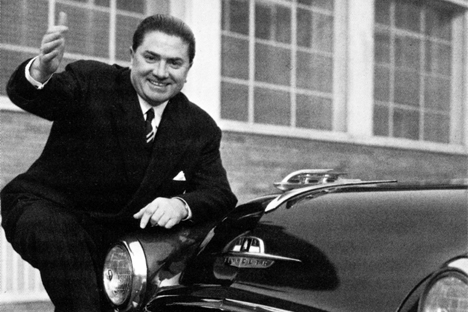
(above, a smiling,
flamboyant Mario Felice Boano
leans on a 1953 Plymouth.) |
|
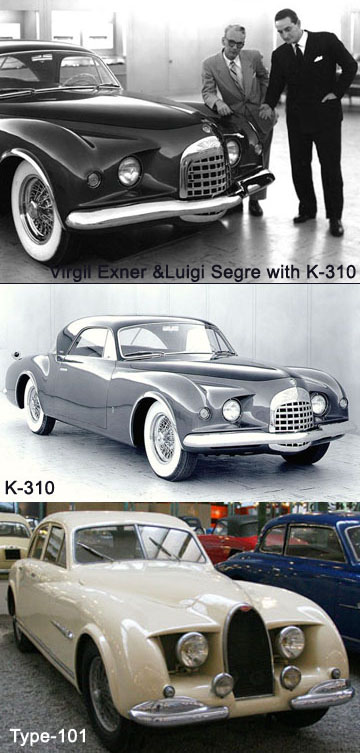
|
So,
beginning around 1949 and continuing well into the 1950s, Chrysler
engaged Ghia for the production of its show cars because, in
post-WWII recovery Italy, labor costs were a small fraction of
U.S. labor costs, and build quality was much higher for these
one-off vehicles. These Ghia dream cars were reportedly built for
as little as $10K, or about 90% cheaper than in Detroit.
The
original Chrysler K-310 "Dream Car", was designed by Chrysler's Virgil Exner and his Detroit team.
The K-310 is the earliest
version of the distinctive headlight treatment that would soon
characterize many Ghia designs in the 1950s, including Alfa Romeo
1900s. While the K-310 may have gotten Boano's attention, I
think the later Chryslers, beginning with the Chrysler D'Elegance,
may have been mostly Boano and/or Savonuzzi creations, or at least
heavily influenced by them in their final forms.
I tend to think that the K-310 headlight treatment was original to
Virgil Exner and Chrysler, but later modifications, such as seen in the D'Elegance and
other cars, may have been inspired by the Bugatti 101 and perhaps was a
Boano/Savonuzzi
influence on Exner's later designs. The Bugatti 101 sedan which was
displayed at the 1951 Paris Auto Salon and is shown here at
the former Schlumpf Museum.
|
|
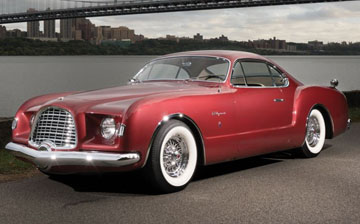
|
In 1953,
Ghia produced the Chrysler d'Elegance dream car, showing a
progression of the K-310's treatment of the front end that comes a
bit closer to the Alfa-style treatment. "The most significant
legacy of the D'Elegance does not involve Chysler at all. Ghia's
Giovanni Savonuzzi was entranced with the design to the point that
he downsized it for several unique Alfa Romeos", according to
RM-Sotheby's description of the D'Elegance for their Icons
auction in December, 2017. |
|
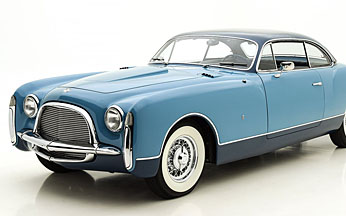
|
Also in the early
1950s, Chrysler began production of a series of 18 Ghia-bodied cars called
the "Chrysler Ghia Special" as a follow-up to the d'Elegance show
car. This example was sold by Hyman, Ltd. and the photo album on their
website reveals this to be a stunningly-restored example of Exner's and
Boano's vision. |
|
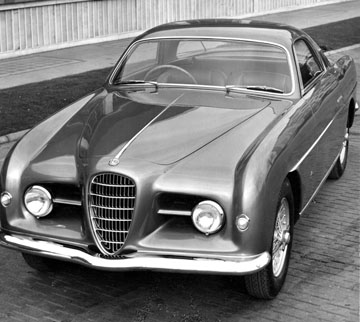
|
Original
press photo of an Alfa 1900 Supergioiello, also built in 1953,
two years after the Chrysler K-310 and the same year as the d'Elegance. Right-hand-drive
(RHD) is correct in this earliest appearance.
This
result of the original collaboration between Boano and
Exner was spreading to Alfa Romeo and other brands. The
Dutch caption above a similar photo states that this car was a father & son
Boano design.
The son, Gianpaolo Boano, also designed a
somewhat grotesque Lancia
Aurelia along vaguely similar lines and "signed" it "B_Junior".
|
|
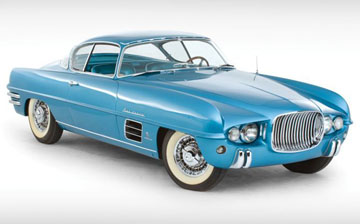
|
The 1953
Dodge Firearrow, another Chrysler show car, clearly is following the
frontal styling direction established by the Chrysler d'Elegance.
And the fender line and headlight treatment continue to be very
similar to that of the Alfa 1900 Supergioiello two-seaters and the
"America" 4/5 seaters such as *01078* and *01085*. |
|
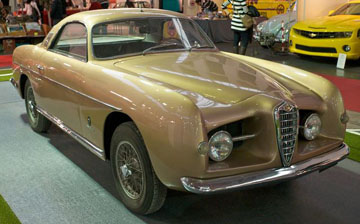
|
Can there
be any doubt that the same hands and mind crafted this car that
crafted the Chrysler and Dodge show cars above? Assuming that Boano
was following Exner's 1951 theme from the K-310, Boano must have
liked the style very much, as he incorporated that look into many
non-Chrysler products. |
|
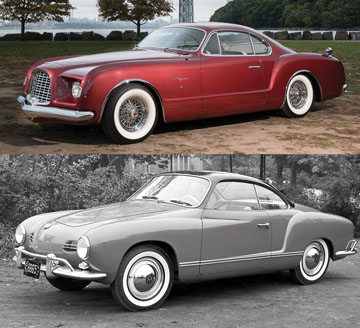
|
 It has been suggested by
others that Carrozzeria Ghia borrowed heavily from the Chrysler
d'Elegance when finalizing their design for a sport coupe for
Volkwagen around 1954-1955. After viewing this comparison, I think
there can be no doubt of that, at least where the
"greenhouse" and rear fender line are concerned. And why
not? Mario Boano headed up Ghia during the early 1950s and his work
would probably have been considered an "in-house" design resource
to be freely used by subsequent designers.
It has been suggested by
others that Carrozzeria Ghia borrowed heavily from the Chrysler
d'Elegance when finalizing their design for a sport coupe for
Volkwagen around 1954-1955. After viewing this comparison, I think
there can be no doubt of that, at least where the
"greenhouse" and rear fender line are concerned. And why
not? Mario Boano headed up Ghia during the early 1950s and his work
would probably have been considered an "in-house" design resource
to be freely used by subsequent designers. |
|
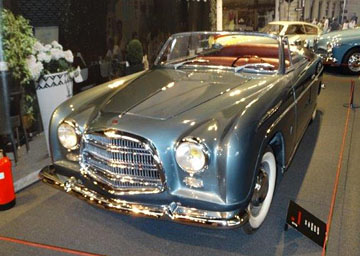
|
And in 2017
I came across this lovely Fiat 1900 Ghia, which more closely resembles the
Chrysler Elegance dream car than the Alfa 1900 Supergioiello. This Fiat,
like the Elegance, was done in 1953. |
|
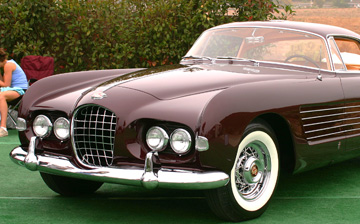
|
This Cadillac Ghia,
also from 1953, bears a closer resemblance to the Alfa 1900 than to the
K-310. Since Exner would have had no involvement in the creation of a
Cadillac show car, the principal designer must have been at Ghia itself, in
Turin, Italy, not in Detroit. |
|
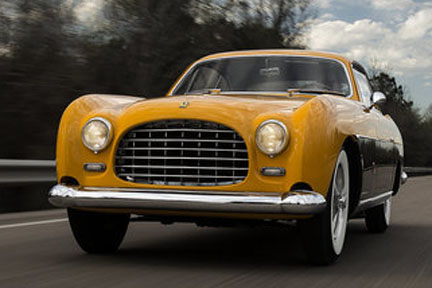
|
This 1952 Ferrari
212 Inter Ghia coupe, shown at the Paris Salon in October, 1952, is clearly
a Boano or Boano-inspired design.

|
|
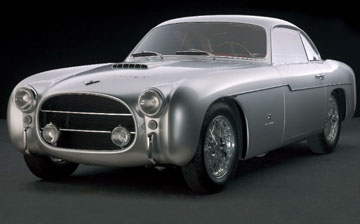
|
This 1954 Fiat 8V
(Otto Vu) has a general form more similar to the Fiat 1900, above, than the
Alfas or Chryslers, so the shape was clearly evolving. However, the literature clearly attributes this car to Mario Boano. In none
of the online references is there any mention or even hint of Giovanni
Savonuzzi, the other major Ghia designer who is sometimes said to have designed
the SuperGs and who was responsible for the Fiat and other Supersonicas, as
well as the Supersonica-style Alfa 1900s. |
|
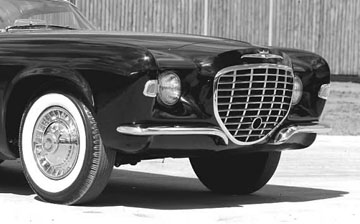
|
Boano left
Ghia in 1954 but, two years later, this 1956 Cadillac convertible
"concept" by Ghia shows the unmistakable hand of Giovanni
Michelotti in the
treatment of the fender form, but the headlight treatment borrows from
Boano's early 1950s work on Chryslers and Alfas. |
|
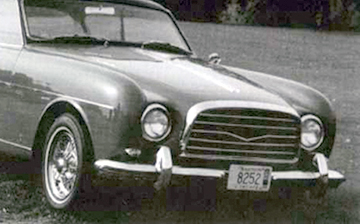
|
And, remarkably,
this same Michelotti/Boano treatment can also be seen on this 1957 Cadillac custom.
Though "watered down" from the 1956 Cadillac example, the headlight and fender treatments
look very
familiar, don't they? |
|
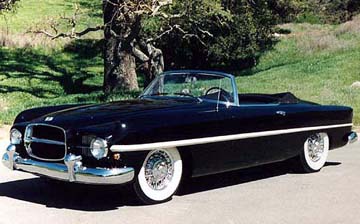
|
But wait...there's
MORE! Remember the Dual Ghia, from Dual Motors? Yep. A Ghia production using
Mario's front-end treatment yet again. Dual Ghia production started in 1957 and ran, with
some updates, through the mid-1960s. The car in the photo at left is the
progenitor of the original run of Dual Ghias, the 1954 Dodge Firebomb (I
don't think such a name would fly today!!). It is virtually identical to the
first run of production Dual Ghias. |
|
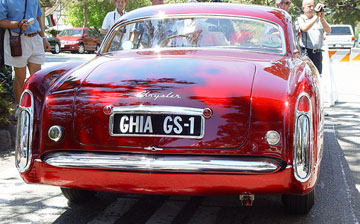
|
There's also a
great similarity between the rear-end styling of the great Chrysler show
cars of the early 1950s and the Alfa Super-Gs. Compare the rear
treatment of the Chrysler GS-1 variation of the Thomas Special (at left) with that of
the bumperless Alfa Supergioiello *01505*, below left, and the Chrysler
"Special", below right. It seems quite clear to me that these came
from the same designer, either personally or by team leadership. |
|
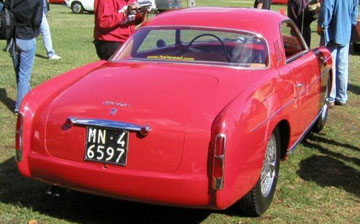
|
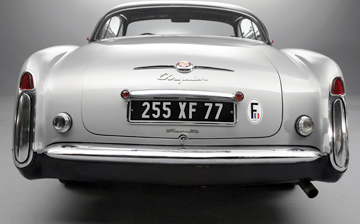 |
|
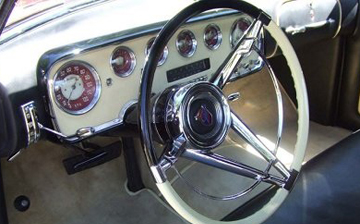
|
Finally,
while the interiors of these many Boano creations varied considerably,
the similar dashboard layouts of the 1953 Chrysler d'Elegance (at left) and
Super-G *01505* (at lower-left) is certainly no coincidence, allowing for
differences in American and continental tastes.
But how much of this work was Mario's and how
much was his son's? Could we be seeing a son's work but crediting the
father? Judging by the clumsy form of Gianpaolo's Lancia Aurelia (bottom
left), I'd say Mario was was calling the shots and his son, if involved in
these cars at all, was merely an aide.
There you have it. Mario Boano was the designer of the Alfa 1900 Supergioiello and the frontally-similar Alfa
1900 "America" and benefitted substantially from his association
with Chrysler's Virgil Exner.
|
|
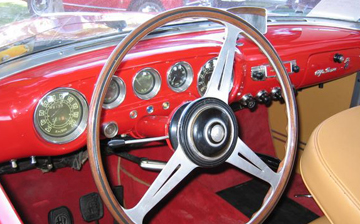
|
|
|
|
|
| *Disclaimer:
Please note that I'm not an expert on these Ghias or even on 1900s
in general, so the opinions and speculations expressed are
strictly my own. |
|


![]()